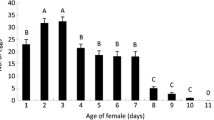Abstract
Hymenopterous parasitoids are key species involved in the regulation of insect populations. Kairomone perception is an important step leading to host parasitization. The massive use of insecticides induces environmental pollution that can interact with the reproduction of parasitoids. In this work, we have determined the sublethal effects of two insecticides, an organophosphorus (chlorpyrifos) and a pyrethroid (deltamethrin), on the arrestment, by host kairomones, of female parasitoids surviving an LD 20 for 24 h. The behavior of the parasitoids has been recorded with a video-computerized system. The analysis of the behaviors in control conditions versus exposed to an LD 20 have shown that both insecticides significantly increased the arrestment of parasitoids by kairomones. This increase was not followed up by a modification of the kinetics of the behavior. In both control and exposed conditions, parasitoids regularly increased their residence time on the kairomone patch indicating that no saturation to kairomones had occurred. In a field situation where hosts could be scarce, this increase in arrestment could be advantageous for parasitoids by increasing their host finding.





Similar content being viewed by others
References
Bartelt RJ, Schaner AM, Jackson LL (1985) Cis-vaccenyl acetate as an aggregation pheromone in Drosophila melanogaster. J Chem Ecol 11:1747–1756
Carton Y, Boulétreau M, Van Alphen JJM, Van Lenteren JC (1986) The Drosophila parasitic wasps. In: Ashburner M, Carlson HL, Thompson JN (eds) The genetics and biology of Drosophila, Vol. 3E. Academic Press, London, UK, pp 347–394
Delpuech JM, Meyet J (2003) Reduction in the sex ratio of the progeny of a parasitoid wasp (Trichogramma brassicae) surviving the insecticide chlorpyrifos. Arch Environ Contam Toxicol 45:203–208
Delpuech JM, Froment B, Fouillet P, Pompanon F, Janillon S, Boulétreau M (1998a) Inhibition of sex pheromone communications of Trichogramma brassicae (Hymenoptera) by the insecticide chlorpyrifos. Environ Toxicol Chem 17:1107–1113
Delpuech JM, Gareau E, Terrier O, Fouillet P (1998b) Sublethal effects of the insecticide chlorpyrifos on the sex pheromonal communication of Trichogramma brassicae. Chemosphere 36:1775–1785
Delpuech JM, Legallet B, Terrier O, Fouillet P (1999) Modifications of the sex pheromonal communication of Trichogramma brassicae by a sublethal dose of deltamethrin. Chemosphere 38:729–739
Delpuech JM, Legallet B, Fouillet P (2001) Partial compensation of the sublethal effect of delthamethrin on the sex pheromonal communication of Trichogramma brassicae. Chemosphere 42:985–991
Finney DJ (1971) Probit analysis. Cambridge University Press, Cambridge, UK
European Official Journal (2001) Amended proposal for a decision of the European Parliament and of the council establishing the list of priority substances in the field of water policy. Official Journal (European Union) C154E:0117–0122
Fleury F, Allemand R, Fouillet P, Boulétreau M (1994) Géographique variation in locomotor activity rhythms of Leptopilina heterotoma: inheritance and role in species richness of the Drosophila parasitoid community. Nor J Agric Sci (Suppl) 16:191–197
Hansson BS, Almaas TJ, Anton S (1995) Chemical communication in heliothine moths. 5. Antennal lobe projection patterns of pheromone-detecting olfactory receptor neurons in the male Heliothis virescens (Lepidoptera: noctuidae). J Comp Physiol A 177:535–543
Health and consumer protection (1998) First common data on pesticide residues in fruit and vegetables. The European Commission. 27/11/98. http://europa.eu.int/comm/dgs/health_consumer/library/press/press17_en.html
Hedlund K, Vet LEM, Dicke M (1996) Generalist and specialist parasitoid strategies of using odours of adult drosophilid flies when searching for larval hosts. Oikos 77:390–398
Komeza N, Fouillet P, Boulétreau M, Delpuech JM (2001) Modification, by the insecticide chlorpyrifos, of the behavioral response to kairomones of a Drosophila parasitoid, Leptopilina boulardi. Arch Environ Contam Toxicol 41:436–442
Menzel R, Müller U (1996) Learning and memory in honeybees: from behavior to neural substrates. Annu Rev Neurosci 19:379–404
Rafalimanana H, Kaiser L, Delpuech JM (2002) Stimulating effects of the insecticide chlorpyrifos on host searching and infestation efficacy of a parasitoid wasp. Pest Manag Sci 58:321–328
Raymond M (1985) Présentation d’un programme d’analyse log-probit pour micro-ordinateur. Cahiers de l’Orstom Serie Entomologie Médicale et Parasitologie 22:117–121
Salerno G, Colazza S, Conti E (2002) Sub-lethal effects of deltamethrin on walking behaviour and response to host kairomone of the egg parasitoid Trissolcus basalis. Pest Manag Sci 58:663–668
US EPA (1999) Quantitative usage analysis: Chlorpyrifos. United States Environmental Protection Agency, November 24, 1998 (last revised September, 27 1999)
US EPA (2000) Alternatives to chlorpyrifos, registered chemical alternatives for chlorpyrifos. http://www.epa.gov/pesticides/op/chlorpyrifos/alternatives.htm
US Federal Register (2000) Chlorpyrifos: Receipt of requests for amendments, cancellations, and notification of tolerance revocation and modifications. Federal Register (USA) 65:56886-56894
Acknowledgments
We are thankful to S. Janillon for her help in laboratory maintenance. This work was supported by the program of research “PESTICIDES” (no. PE00/122000/024) of the French Ministry of Environment (Ministère de l’Aménagement du Territoire et de l’Environnement).
Author information
Authors and Affiliations
Corresponding author
Rights and permissions
About this article
Cite this article
Delpuech, J., Bardon, C. & Boulétreau, M. Increase of the Behavioral Response to Kairomones by the Parasitoid Wasp Leptopilina heterotoma Surviving Insecticides. Arch Environ Contam Toxicol 49, 186–191 (2005). https://doi.org/10.1007/s00244-004-0158-1
Received:
Accepted:
Published:
Issue Date:
DOI: https://doi.org/10.1007/s00244-004-0158-1




